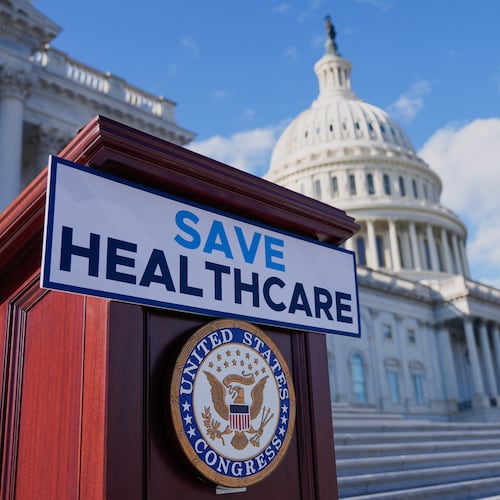As Gov. Brian Kemp started work back in 2019, higher-income Georgians getting insurance on the federal Affordable Care Act health insurance marketplace had a problem: As a person’s income climbed higher, the federal subsidies that make ACA premiums affordable for shoppers faded out. No one who earned more than $103,000 a year for a family of four got any subsidy at all and they were asked to pay the full cost of premiums.
So Kemp took a cue from several other states and launched a state subsidy program to help those people, called “reinsurance.” But now, some researchers have found that those reinsurance programs, which can cost state taxpayers hundreds of millions of dollars a year, helped some shoppers at the expense of others.
The study, published in March by researchers at Duke and other universities, found that when Georgia’s reinsurance program launched in 2022, it had an unintended effect of reducing subsidies offered to some people who earned less. The study concluded it caused thousands of Georgians to be unable or unwilling to buy insurance.
The study focused only on Georgia, but the authors say it has implications for all states across the country who use reinsurance.
The ACA marketplace for health insurance, known as Obamacare when it launched in 2013, was designed to offer federal subsidies to families based on their income. In Georgia, more than 1.2 million people signed up for 2024 plans.
Georgia’s reinsurance program began in 2022. The program continues today, and is budgeted to cost the state $336 million in this fiscal year, according to government figures. By the end of this fiscal year in June, over the years the state will have put more than $1 billion into the plan.
Study authors said Georgia’s reinsurance program jumbled the federal subsidy calculations for people who make under 400% of the federal poverty level. For the cheapest plans, it caused federal subsidies to be lowered. Those shopping for the cheapest plans, who made annual incomes between $33,975 and $54,360 in 2022 for a one-person household, found prices that were 30% more expensive than they would have been without the reinsurance program.
As a result, the study claims, 21,000 people in that income bracket did not get ACA insurance. It points out that’s compared to fewer than the 2,000 people Georgia projected would be added to the insurance rolls by reinsurance.
“I don’t think it’s intentional,” said David Anderson, lead author of the study. “I think it was just a question that the (contractors) who put together these plans for every state — big state, red state, small state, blue state, it doesn’t really matter — it was not something that they were thinking about.”
Federal subsidies for ACA insurance are based on a range of factors, but a big one is how much a particular plan’s premium price differs from the premiums for the “benchmark” plan — the second-lowest cost ACA plan offered in a county. As those premium differences change, federal subsidies get recalculated.
In addition, a major goal of Georgia’s reinsurance program at that time was to keep insurance companies from fleeing the ACA exchange. That was a problem in the first years of the ACA a decade ago. Some other states had “bare” counties with no ACA plans. Georgia avoided that, but some counties went down to only one insurance company to “choose” from. Reinsurance is often cited as one of the programs that helped lure more competition back into the fold.
At least 16 states have reinsurance programs now.
“Once again, the AJC prioritizes commentary and half-baked claims over facts,” Garrison Douglas, Kemp’s spokesman, said in a written statement touting the benefits of “Georgia Access,” Kemp’s name for his group of initiatives affecting the ACA market. “Here’s the truth: Georgia Access has slashed premiums statewide by 11%, broadened our insurance carrier network, and provided quality, affordable private health insurance plans to over 700,000 low-income Georgians.”
The 700,000-plus Georgians Douglas referred to are those who earn just over the federal poverty level, and they have flooded onto the exchange in Georgia this year. Experts say the main reason for the increase is that Congress increased subsidies to make ACA plans virtually free to that population. Reinsurance isn’t likely to be the reason, experts say. But Georgia did fund heavy advertising for ACA insurance last year, which probably helped draw in people to shop.
A written statement from the federal Centers for Medicare and Medicaid Services, which approved Georgia’s reinsurance program and that of every state that operates one, echoed Kemp’s aides in pointing to the overall average. State innovations including reinsurance, the federal statement said, “have resulted in statewide average premium reductions ranging from 3% to 40% for residents.”
Looking at the overall average and not the individual impacts is the problem, said Anderson. He said his aim with this study was to push state and federal policymakers to stop concentrating on one big number and start investigating the impacts on the groups of people that make up the whole.
Greg Fann, an actuary who agrees with Anderson, said the study’s conclusions were “obvious.” Fann is a California-based consultant with Axene Health Partners and works on ACA programs for states and other customers.
“It ends up costing the state money and costing some consumers more money,” Fann said. “It’s very convoluted and it’s good that this paper’s exposing it.”
The problem that reinsurance was designed to solve is less important now. Higher-income people now can get federal subsidies, after Biden pandemic legislation started offering subsidies across the board. No matter how high their income level, no family should now pay more than 8.5% of their income on health premiums. That federal legislation is set to expire in 2025, but state reinsurance will continue.
An expert with the Brookings Institution, Matt Fiedler, took the new paper with a grain of salt. The overall findings make sense, Fiedler said. But the numbers are really hard to measure, he added. He would not be surprised if the actual enrollees lost were 21,000, he said, but he also would not be surprised if the number were much lower.
That’s important. By federal law, reinsurance programs must not lower the overall number of people the ACA marketplace insures.
The study did not come up with statistically significant conclusions about any other income group, or how the overall number of policyholders may have been increased or decreased.
Georgia’s Office of the Commissioner of Insurance and Safety Fire said the study raised important questions but ignored important answers.
“It’s important to note that the reinsurance program was designed to stabilize the market,” and it did that, lowering prices statewide and drawing competition, the office said in a written response. “These developments have contributed to a broader benefit across the state, demonstrating the program’s effectiveness in increasing market stability and consumer control over their own health.”
AJC staff editor James Salzer contributed to this story.
This story has been updated to reflect more exact figures on the cost of the reinsurance program in Georgia.
Credit: John Spink/AJC
Credit: John Spink/AJC
About the Author
Keep Reading
The Latest
Featured





